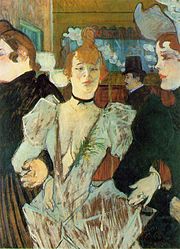Albi
- For the city in Calabria, Italy, see Albi, Italy.
Albi | |
|---|---|
 Cathedral | |
 | |
| Country | France |
| Arrondissement | Albi |
| Canton | Chief town of 6 cantons |
| Time zone | UTC+01:00 (CET) |
| • Summer (DST) | UTC+02:00 (CEST) |
| INSEE/Postal code | 81004 / |
Albi is a town and commune in southern France. It is the préfecture (capital) of the Tarn département, and is located on the Tarn River, 50 miles northeast of Toulouse. Its inhabitants are called Albigensians (French: Albigeois/ Albigeoise(s)).
Administration
Albi is the chief town of 6 cantons, covering 18 communes, with a total population of 67,729.
History
The first human settlement in Albi was in the Bronze Age.
After the Roman conquest of Gaul in 51 BC, the town became "Civitas Albigensium", the territory of the Albigeois, "Albiga". Archaeological digs have not revealed any traces of Roman buildings, which seems to indicate that Albi was a modest Roman settlement.
In 1040, Albi went through a period of expansion with the construction of the Pont Vieux (Old Bridge). New quarters were built, indicative of considerable urban growth. The city grew rich at this time, thanks to trade and commercial exchanges, and also to the tolls charged for using the Pont Vieux.
In 1208, the Pope and the French King joined forces to combat the Cathars, who'd developed their own version of Christianity (a dangerous heresy to the dominant Catholic faith). Repression was severe, and many were burnt at the stake throughout the region. The area, until then virtually independent, was reduced to a state that enabled it to be annexed to the French Crown.
After the upheaval of the Albigensians crusade against the Cathars, the bishop Bernard de Castanet, in the late 13th century, completed work on the Palais de la Berbie, a Bishops' Palace with the look of a fortress, and ordered the building of the impressive cathedral of Sainte-Cécile starting in 1282.
From 1450 to 1560, Albi enjoyed a period of commercial prosperity largely due to the cultivation of "Isatis Tinctoria" commonly known as woad. The superb town houses of the Renaissance bear witness to the vast fortunes amassed by the pastel merchants.
Albi has conserved its rich architectural heritage which encapsulates the various brilliant periods of its history. A great deal of improvement and restoration work has been done, to embellish the old quarters and to give them a new look, in which brick reigns supreme.
Main sights
Albi was built around the original cathedral and episcopal group of buildings. This historic area covers 63 hectares. Red brick and tiles are the main feature of most of the edifices.
Along with Toulouse and Montauban, Albi is one of the main cities built in Languedoc-style brick .

Among the monuments of the town is the Sainte Cécile cathedral, claimed to be the world's largest brick construction. This monument is a masterpiece of the Southern Gothic style. It is characterized by a strong contrast between its austere, defensive exterior and its sumptuous interior decoration. Built as a statement of the Christian faith after the upheavals of the Cathar heresy , this gigantic brick structure was embellished over the centuries: the Dominique de Florence Doorway, the 78 m high bell tower the Baldaquin over the entrance (1515–1540). The rood screen is a veritable filigree work in stone in the Flamboyant Gothic style. It is decorated with a magnificent group of polychrome statuary carved by artists from the Burgundian workshops of Cluny and comprising over 200 statues which have retained their original colours.
Older than the Palais des Papes in Avignon, the Palais de la Berbie, formerly the Bishops' Palace of Albi, now the Toulouse-Lautrec Museum, is one of the oldest and best-preserved castles in France. This imposing fortress was completed at the end of the 13th century. Its name comes from the Occitan word Bisbia, meaning Bishops' Palace.
The Old Bridge (Pont Vieux) is still in use today after almost a millennium of existence. Originally built in stone (in 1035), then clad with brick, it rests on 8 arches and is 151m long. In the 14th century, it was fortified, reinforced with a drawbridge and houses were built on the piers.
Albi is a well known city for its elite Lycée Lapérouse, a high school with 500 students situated inside an old monastery boasting several literature classes. Furthermore, it is one of the few holding a full scale music section with special high tech rooms for this section.
Albi is the home of the Toulouse-Lautrec Museum. More than 1000 works, including the 31 famous posters, are kept within the walls. This body of work forms the largest public collection in the world devoted to Toulouse-Lautrec.

Sport
- SC Albi - The city's rugby union team and a product of the rugby league ban by the fascists in 1940.
- Albi held Stage 13 of the 2007 Tour de France. The stage was a 55 km individual time trial which started and finished in the city.
Famous people
Albi was the birthplace of:
- Henri de Toulouse-Lautrec (1864–1901), painter
- Gérard Onesta (born 1960), politician and Member of the European Parliament
- Pierre Benoît (1886-1962), novelist
- Jean François La Pérouse(1741-1788), explorer
Twin towns
Albi is twinned with:
External links
- Tourist Office of Albi
- Albi official Website in english
- Albi official Website in french
- Visiting Albi (English)
- Albi photographs,history etc. (English)
- Archdiocese of Albi (Albia) - Article from the Catholic Encyclopedia 1908
- Walking tours of Albi - cathedral, Toulouse-Lautrec Museum, Old City

